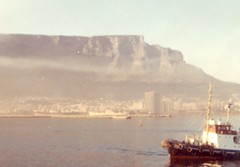
I was a college student, among ~525 undergrads aboard the S.S. Ryndam, leased to Chapman College’s World Campus Afloat program. We were about a third of our way around the world, excited to touch land for the first time in 10 days, but we were apprehensive about our reception. Ours was a mixed race student body - we had a handful of non-white students - and we were about to step ashore into the land of apartheid. Some thought we should not be stopping at all. Probably none of us knew at the time that we had just passed an island in the harbor where Nelson Mandela was being held prisoner. He could have seen us arrive.
This afternoon I watched two matches of the 2010 World Cup, live from South Africa. As I watched the sides play on I could not help remembering my experiences in Capetown - and Durban a few days later - experiences that helped shape my view of the world, and myself.
Our voyage had not been scheduled to visit Africa south of Egypt. But in June of 1967 war closed the Suez Canal creating the opportunity to visit Morocco, Senegal, South Africa, and Kenya. The Mediterranean was out, Africa in. I still haven’t seen Marseilles, Rome, Athens, Istanbul or Cairo, but I would not change a thing.
Of course the South African government knew we were coming. Already somewhat a pariah among nations because of their racial policies, the country’s white rulers must have seen our visit as an opportunity to put their best face forward. I do not know what agreements were made between the college and our hosts, but all of our student body members were made whites for the duration. So all of us used the white’s only facilities, store entrances, transportation, parks, and beaches. If anything this added a surreal element to what was then a most unique educational experience. But for me, who had lived all of his short life in Virginia, the segregating signs were not the shock they were to most of my classmates.
Just to insure all would go well we were met first thing that morning by a launch which brought newspaper photographers. By the time we landed the Cape Argus was on the streets with two of our black students prominently shown on page one.
Our visit went well. Even though we were 60’s college students and were beginning to get adventurous the more we traveled, we were good guests, the South Africans gracious hosts. I am sure this was to the great relief of all concerned. This is not the place for details - my personal experiences - but I sailed away with three dominant impressions. First, the South Africa I saw was take-your-breath-away beautiful. Almost paradise. I could live there in a heartbeat. Second, Capetown was a thoroughly modern city, the equal of any I had seen. Last, my heart cried for the people, all of the people. Apartheid was damaging all it touched. Like many, I did not think it would end well; and it would end.
So years later, in February 1990 when Nelson Mandela walked out of his prison I watched my TV from the top of Mineral Spring Mountain and thought of Table Mountain with a lump in my throat. I watched him later become the country’s elected President and guide his people - all of his people - through difficult but relatively peaceful transition years. The feared bloody chaos did not happen. And while South Africa continues to have many problems as a nation, it is probably still just as beautiful as it was that morning in 1967 as it hosts this month the largest sporting event in the world.
So, here is to the South Africans, black, white, colored and Indian, who made it possible for me to get that lump in my throat again.
No comments:
Post a Comment